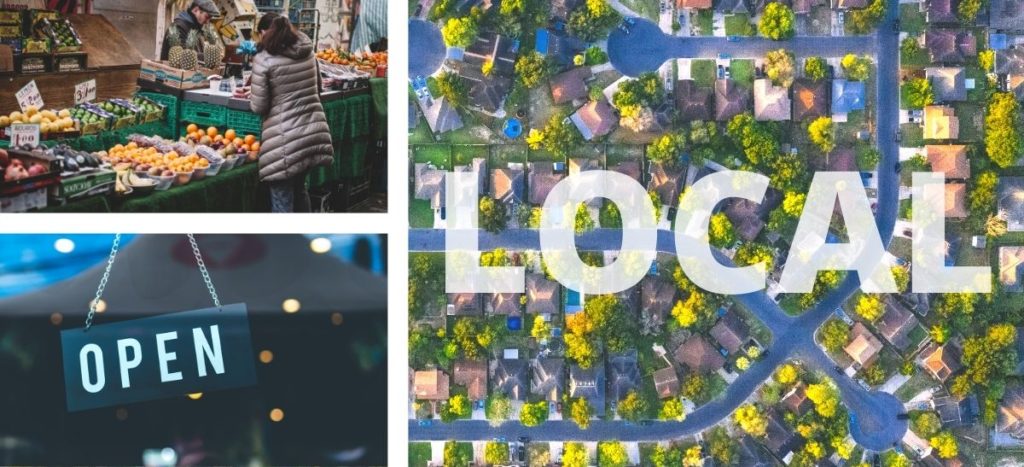Please welcome Jordyn Divok, a devoted team member of Sustainable Hamilton Burlington and the Sustainability Leadership Program who is our guest blogger for this month’s post reflecting on this month’s theme of supporting local.

As a geography grad, I’ve been a part of many conversations about “space” and “place” – and believe it or not, no, they are not the same thing. In geography, “space” is a term that does not just explain where, for instance, economic activities exist, but can also help explain why those activities happen where they do (Coe et al, 2012). One of the four concepts of space is “place”. In particular, place is formed when a space takes on certain characteristics or meaning to those that interact with them (Coe et al, 2012). Places have cultural or political significance, and shape economic patterns – but in turn, are shaped by those economic patterns. Places undergo a cyclical shaping process, in which a sense of place is layered by topographical, historical, cultural, political, and economic factors, resulting in an evolution of that place. For businesses to succeed, becoming a part of and contributing to a local sense of place can result in competitive advantage. This is why businesses that understand and align with the communal sense of place can embed their organization into the very existence of that place; they, and their community, can thrive.
Small businesses actually have some advantages compared to larger corporations when it comes to contributing to the local community and building the business’ sense of place. Firstly, small businesses have the opportunity to cater to the local needs of the community. Where larger businesses have specific services or products they sell based on corporate policies and expectations, small businesses have the ability to shift and adapt to the niche needs of their clientele (BBB, 2019). Also, when customers support small local businesses, the revenue is two times more likely to be reinvested within the community, since they are more likely to support other local businesses through their supply chain (Wirthman, 2017).
That being said, both small business and large business within a given place have the opportunity to build their competitive advantage through corporate-social responsibility (CSR) strategy (Fernando, 2021). An ever-winning CSR strategy is to create philanthropy opportunities within local communities – both those the organization serves directly, or those of its supply chain. For example, an organization can support employees through paid days off to volunteer within the community. Depending on the volunteering policy, employees can choose community events that interest them to volunteer their time, or the organization can promote events at which their employees can participate. Either way, if a business supports their employees in giving back to the community, it strengthens and deepens the business’ community connection.
Businesses can also strengthen their community ties by donating and sponsoring community teams, fundraisers, or other events (Fernando, 2021). This can be as simple as donating supplies, equipment, or knowledge sharing to local community organizations. One of our Program members, ArcelorMittal Dofasco, invests in STEM (science, technology, engineering, and mathematics) through an annual local high school science fair. Although ArcelorMittal is a global organization, this investment in the local community networks provides a benefit to the communities by inspiring a passion for STEM (Annual Impact Report, 2019).
One of our Program members, ArcelorMittal Dofasco, invests in STEM (science, technology, engineering, and mathematics) education to ensure that local communities have access to STEM opportunities. Although ArcelorMittal is a global organization, this type of grant-funding through partnerships with local community networks provides a service to the communities in which they reside (Annual Impact Report, 2019). Lastly, organizations can develop programs that demonstrate their leadership in supporting local communities throughout their supply chains (Fernando, 2021). For example, Starbucks has developed numerous programs and partnerships to support ethical production and harvesting of their coffee beans, with approximately 99% of their coffee being ethically sourced (Fernando, 2021). Organizations that build their sense of place, and are identified as leaders within the local communities improves their brand recognition. Through corporate-social responsibility strategies, small and large organizations can build their competitive advantage at the local scale, whether in a single community, or across multiple communities and geographies.
As you can see, there are many diverse opportunities available to businesses to build their connections to a local sense of place. Whether your business is located in the heart of one community, or spans across many localities, developing your sense of local connection can improve your brand’s reputation, positively adding to the place(s) in which it operates.
Sources.
Coe, N., Kelly, P., & Yeung, W.C. (2012). Economic Geography: A Contemporary Introduction. John Wiley & Sons, Inc.
Fernando, J. (2021). Corporate Social Responsibility. Investopedia. Retrieved from https://www.investopedia.com/terms/c/corp-social-responsibility.asp
None (2019). 10 Ways Small Businesses Benefit their Local Communities. BBB. Retrieved from https://medium.com/@BBBNWP/10-ways-small-businesses-benefit-their-local-communities-7273380c90a9
None. (2019). Annual Impact Report. Retrieved from https://sustainabilityleadership.ca/taking-action/annual-impact-report/air2019/2019-air-sustainability-awards/
Wirthman, L. (2017). 5 Benefits of Shopping Locally on Small Business Saturday. Forbes. Retrieved from https://www.forbes.com/sites/centurylink/2017/11/20/5-benefits-of-shopping-locally-on-small-business-saturday/?sh=4125c47e668b


